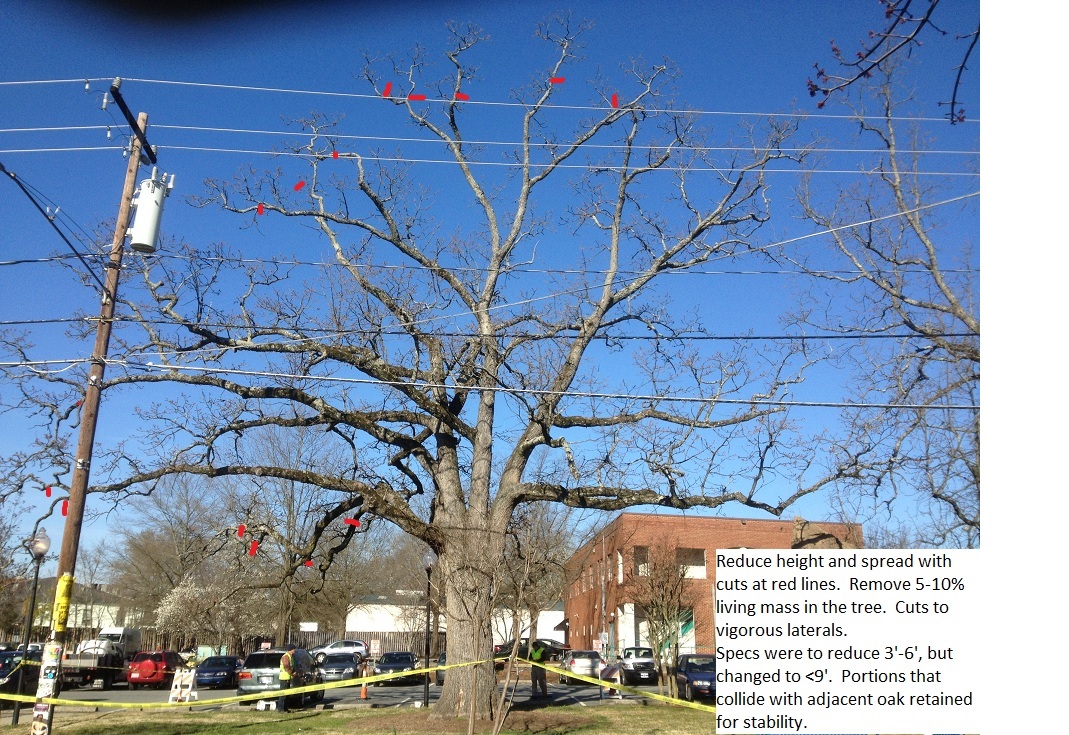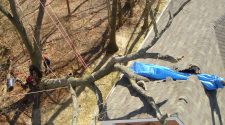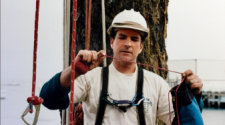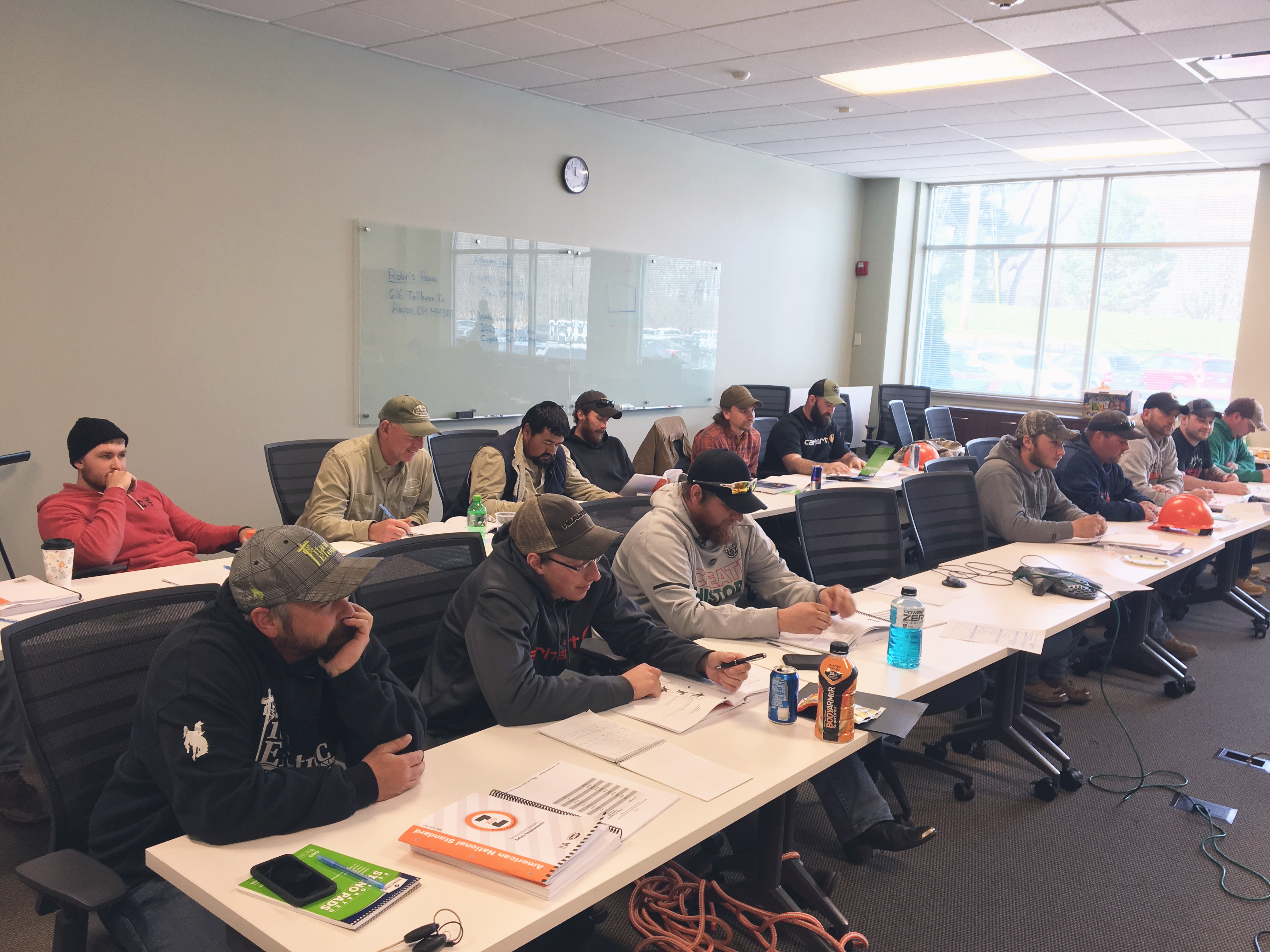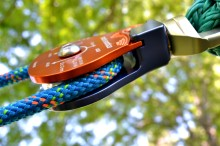REGENERATING HOLLOW TREES FOR LIFE Guy Meilleur, guy@historictreecare.com
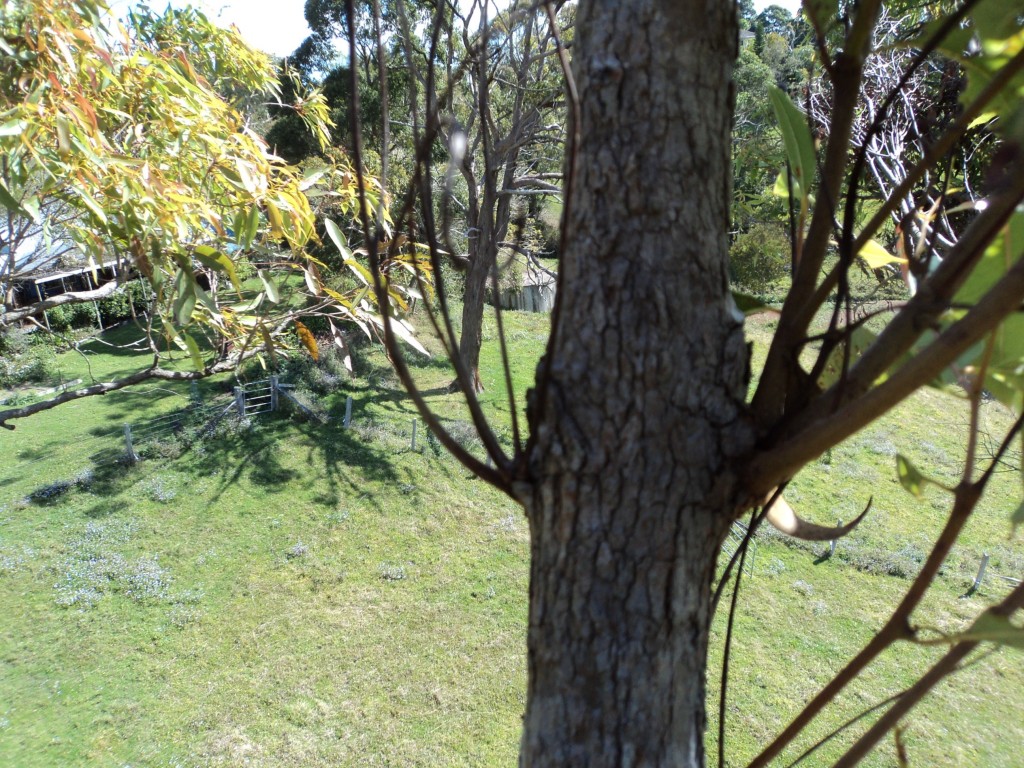
Dormant buds on this Corymbia intermedia, pink bloodwood, are sprouting at a growth point, or “node”, after the end was reduced. The sprouts on the left are withering due to shade. The sprouts on the right harvest sunlight, form buttresses, and transition from epicormic to endocormic. The reduction in diameter, or “taper”, beyond these sprouts delineates the location of a proper reduction cut, with or without the lateral branches. ‘Retrenching’ has been used in relation to trees and their care since the 1700s. Dictionary definitions include: To live at less expenses; To confine, limit or restrict; To cut off, pare away; To reinforce. In the UK standard, “Retrenchment pruning is a phased form of crown reduction… whereby the crown of a declining tree retains its overall biomechanical integrity by… development of the lower crown (retrenchment)… shortening heavy, long or weakened branches throughout the crown, while retaining as much leaf area as possible and encouraging the development of new secondary branches…”¹ Regenerating a smaller crown is the goal, so the German ZTV standard calls it “Regenerative Pruning: Trees showing significant signs of aging in the outer parts of the crown and the development of a secondary crown are to be cut back as far as necessary (crown reduction)… with safety requirements and/or the surrounding tree environment. If necessary, areas surrounding the sections that have been reduced may require thinning to establish symmetry (and light penetration to inner foliage—ed.). The extent… is specifically dependent on the species and growth habit, and shall be less than 20 per cent… Form a secondary (reiterative) crown over time.”2 Identifying and preserving the natural ‘habitus’ or architecture comes first in the ZTV. This process was spelled out in 1999’s Pruning with the Laws of Nature3, Jochen Pfisterer’s hybridisation of Japanese, bonsai and European techniques. Meanwhile, globetrotting arborist Henry Davis III was back in the US after visiting those same regions. He eagerly applied a similar synthesis to managing hollow historic trees in Boston, Massachusetts. His work on Structural Pruning, a merger of Niwaki tradition with European awareness of physiological and ecological systems, was published in September 2002 and May 2003 (archived at tcia.org). Davis’ pruning specifications for hollow historic trees include:
- Objectives: safety, survival, aesthetics
- Inspect hollow tree structure closely, and at a distance. Consider supplemental support systems
- Locate dominant leaders, and an ‘inner crown’ to regenerate
- Choose 4-10 large branches that could be reduced or removed
- Start pruning from the top down, heaviest side first, tips last
- Retain dead lower branches except for safety or sanitation
Definitions and parameters for regenerative pruning have long been established, so “Tree risk assessors should resist the ultimate (but false—ed.) security of risk elimination based on tree removal and consider possibilities for retaining trees when practicable… trees in natural settings may reconfigure… a process sometimes called ‘natural retrenchment’. They may continue to grow trunk diameter while branches die and fail – reducing overall height of the tree and increasing stability… tree risk assessors can imitate this process by recommending crown reduction.”4Templates for crown regenerative specifications, based on successful results with many species, are tools for VETree: Valuing and Managing Veteran Trees, a European training program that is becoming available worldwide. Until this knowledge becomes more familiar, arborists who are still taught that crown reduction is undesirable might still wonder: Is regenerative pruning the same as ‘lopping’?
| REGENERATION VIA CROWN REDUCTION | TOPPING |
| Retains enough foliage to maintain tree health | Removes too much foliage, starving the tree |
| Releases gradual sprouting from interior nodes | Forces panic sprouting internodally or near wounds |
| Endocormic growth from dormant, fully formed buds. Sprouts well attached by buttressing | Epicormic growth from adventitious (newly formed) buds. Sprouts weakly attached, no buttressing |
| Smaller wounds where tree can compartmentalise | Large wounds at poor locations causing rapid decay |
Young trees are trained to get big fast. Reduction of permanent branches leaves a lateral large enough to assume apical dominance (at least 1/3 diameter). Outward growth is pushed. Cuts to small laterals or buds are called ‘heading’, and avoided. For mature trees, it’s the exact opposite. Apical dominance is not desired, because it extends lever arms, and increases risk. Interior growth is pushed, so the ‘heading’ concept is irrelevant. Cuts to small laterals and buds promote a favourable response. If the lateral remaining is less than 1/3, “it should be fairly upright…Old trees that are of low vigour and have failing branches can often be kept healthy and attractive by removing the weak-growing and dying limbs in their extremities, particularly their tops.”5
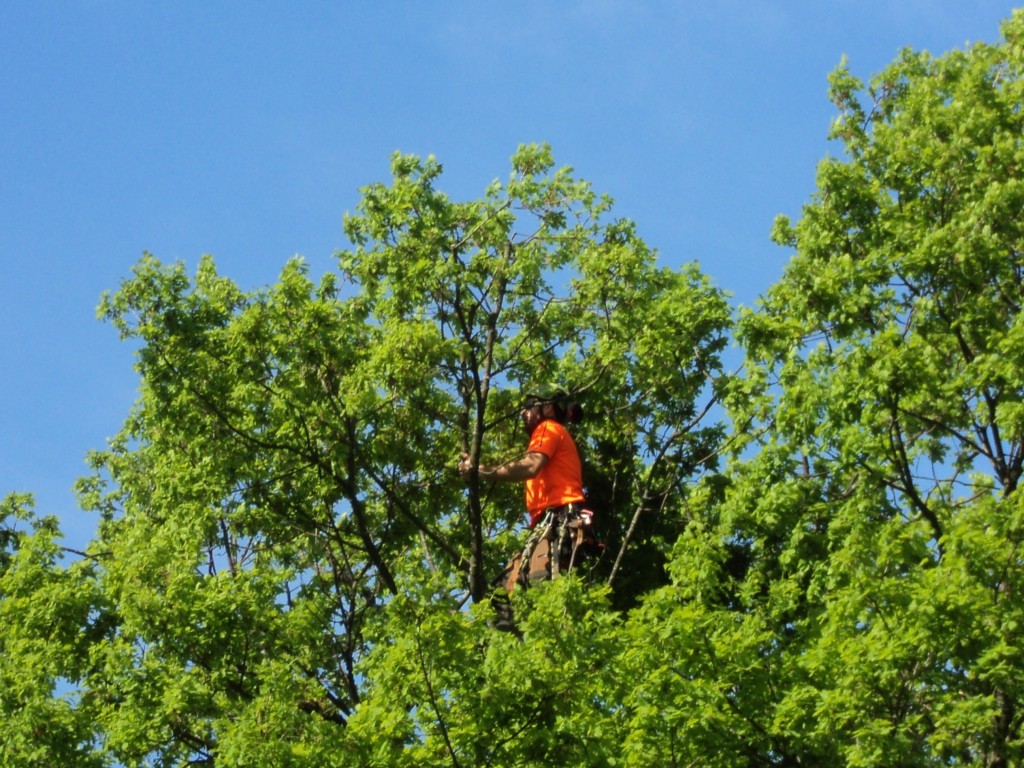
Thinking in ‘tree time’, arborists apply age-appropriate guidelines, and conserve more trees. It doesn’t take much – a 15 per cent reduction can increase stability by 50 per cent, in trees6 and branches7.
The Tradmastarna specification was to reduce the crown by roughly one meter (3.3 feet), and literally take the ‘whip’ out of it. Tradmastarna climbers used their bodies to move the branches, and reckoned the points where branches bent were natural pruning targets. Then they felt around these locations with their hands for the taper, where the cut would be as small as it could be.
Regeneration develops a new, smaller structure, in effect a big bonsai. Dr. Ed Gilman told me: “In Sweden, 600 to 800 year old trees have been reduced for hundreds of years. They have 4 or 5 foot trunks – some even larger – with 4 inches shell wall. We remove too many trees and prune too few!”, so I very fortunately connected with the company “Tradmastarna” (which hires climbers May-August) to learn how this was done. One old oak in a high-traffic area in Sweden’s Royal Botanic Garden was festooned with Phellinus conks. One conk, heavy as a bowling ball, fell to the ground as the tree was climbed, and was given to a passing tour group. They were quick to grasp the concept of Growing Downward, and gave a positive response to the pruning works.
Informational text is italicised and included within the German ZTV and British 3998 standards, easing access for users. Both discourage cuts over 4 inches, a criterion based on substantial research. The current US standard has no informational text in the body of the standard, and few illustrations. Its legalistic text is hard to understand, and harder to use. The ZTV makes extensive use of sketches, and the standard in Taichung, Taiwan classically merges science and art:
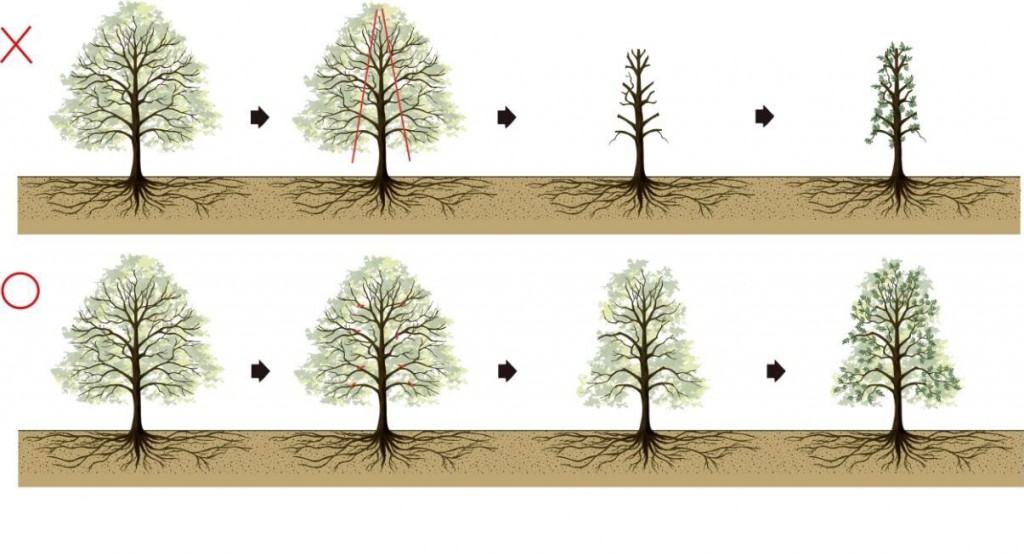
“X” shows the effects of topping, while “O” shows light reduction leading to regeneration. [
Regenerative pruning is a form of directional pruning. It follows acceptable standards when the objective is established, the requirements are met, and specifications are communicated in a way that both workers and clients understand. For example, if the objective is “Post oak 6-feet wide at base, 5-feet hollow, root damage: Increase health and value over time, lower cost, risk, and load,” specifications could fit on a pocket-sized card:
- Remove outer dead branches greater than 1-inch diameter
- Reduce sprawling leaders. Cuts less than 3 inches to uprights, less than 8 per cent total foliage
- Reduce downward and horizontal branches. Clear growth below by 2-4 feet. Less than 4 per cent total
- Thin crowded branches. Less than 2-inch cuts, less than 3 per cent total
- Smallest cut possible, near vigorous growth or buds
- Start 3 feet from the trunk to 20 feet: make holes greater than 2 inches wide, 18 inches apart, greater than 12 inches deep. Force 50 per cent expanded aggregate and 50 per cent specified soil conditioner under pressure into the holes. Irrigate. Mulch 2-inch woodchips
The Objective is directly delivered by the specifications. Inserting “type or method of pruning “or “type of cut” into the process just gums up the works. Simple terminology yields simple specifications. According to TCI magazine (May 2014), the corporations that dominate the US pruning standard’s revision will “review and incorporate changes in industry standard practices… Harmonisation with related industry standards will be considered.” We and our trees are related to more experienced people and trees overseas. It’s only natural to harmonise with streamlined, inclusive approaches to tree pruning. Specification writing can become a habit, by practicing a simple process that meets a clear objective set by a competent assessment. Speculation that pruning cannot reduce risk to an acceptable level ignores sound science and proven practice, and leads to the needless loss of valuable trees.
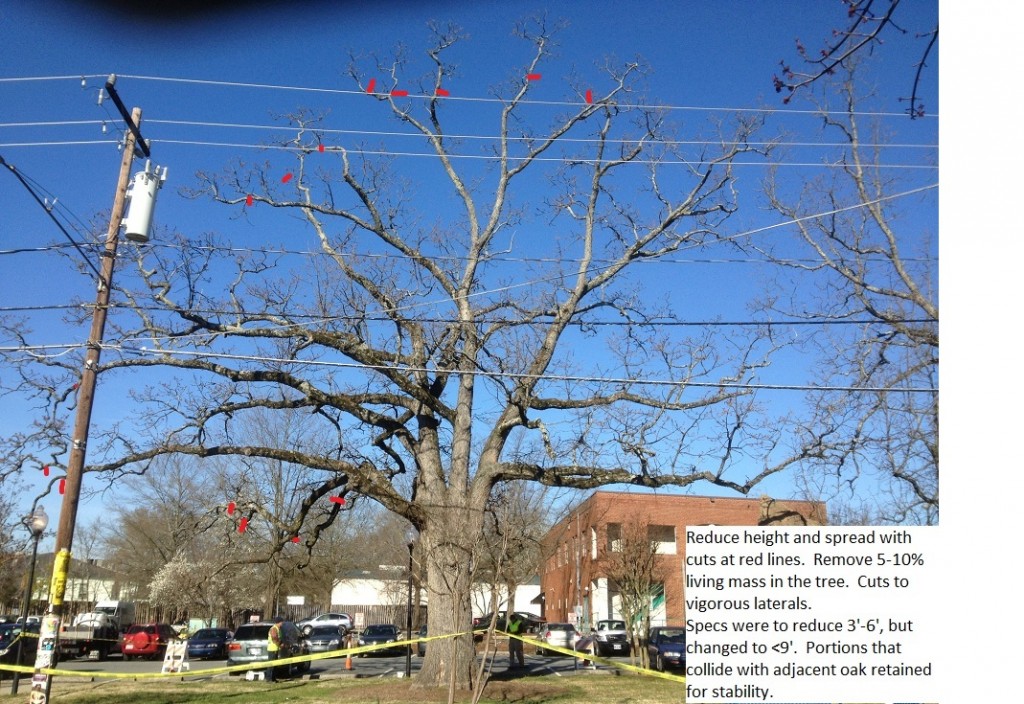
Over 90% hollow at the base, this tree was slated for removal after an incomplete and defective assessment. One climber in 5 hours gave it a pruning that will last.
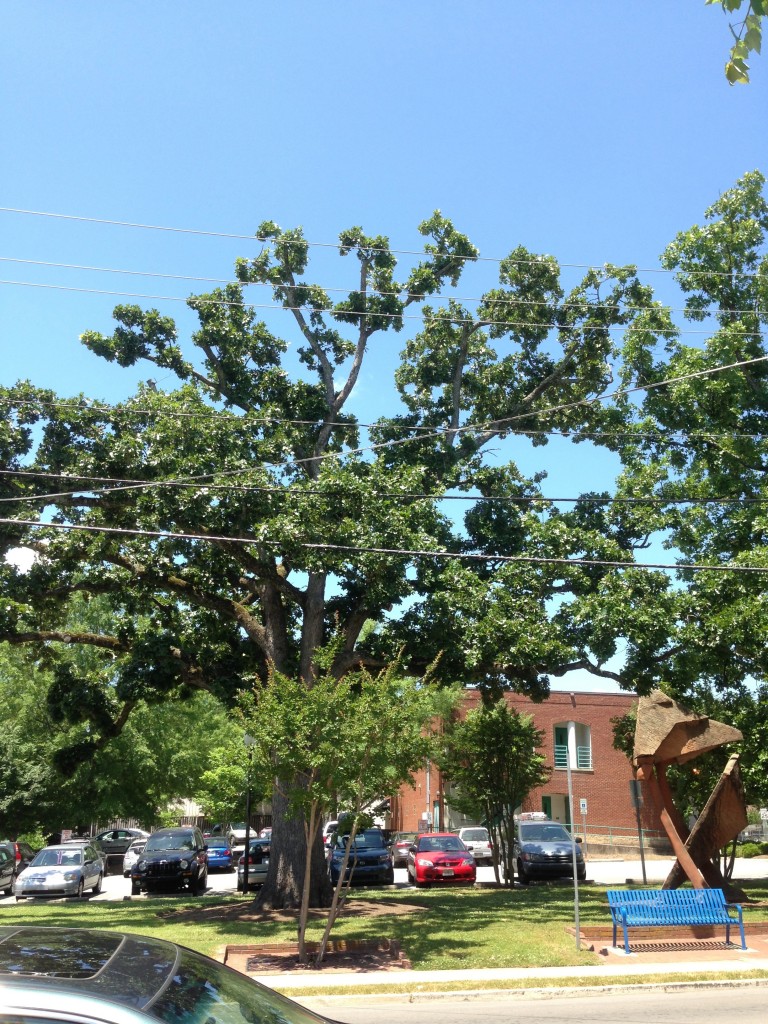
“Considering risk and mitigation measures, tree risk assessors should communicate the benefits of trees as well as the consequences of losing them. Guidelines should be considered a starting point and should be modified as needed so that they are appropriate for the tree and site. While ‘likelihood of failure’ guidelines are presented… it is essential to consider all of the aggravating factors as well as any mitigating factors such as adaptive growth in the tree4”, like the trunk flaring out at the base.
The concave areas between the buttress roots, the sinuses, are often wounded by included bark as expanding buttress roots collide. Insects and fungi colonising these sinuses often warrant simple IPM treatments, such as cleaning and drying. Tree structure is supported by buttresses, so sinus problems are typically not structural problems. Buttresses can function as independent segments with separate vascular streams. Overstating strength loss from decay skews conclusions toward removal. So does exaggerating the need for future care, and misjudging occupancy in target ratings.
People understand it makes sense not to linger outside during storms, so occupancy ratings are low when failures are likely. It’s harder to make sense of abstract methods of managing hollow trees. Numbers are proposed: if less than 30 per cent of the trunk diameter is sound wood, trees could be considered a high risk. However, there is no data behind applying this rule to trees greater than 36 inches dbh. It is often applied without considering the tree: its height, exposure, species, condition, wood strength, and many other factors.
“The ratio t/R <.3 can no longer be used by itself as an index of trunk failure potential. Trees can tolerate extremely large amounts of internal decay without necessarily incurring adverse effects on their stability.” 8
Physicist Frank Rinn, developer of decay detection tools, calls overreliance on formulas “Voodoo”. Trees shed their taproots, and their heartwood, naturally. Hollowing recycles waste products, and sheds weight. Wood decay fungi are associates, unless they are proven pathogens, by colonising sapwood. In Asia and Europe, hollow trees are revered, and celebrated as tourist attractions.
North Americans also value and manage a growing number of veteran trees, by appreciating their strength. “Hollowing increases flexibility. Tubes are very strong structures.” Karl Niklas of Cornell University cites these facts to plug “very large gaps in our knowledge regarding the mechanical behaviour of trees… Conclusions from research into the science of mechanics are severely limited by simplifications and assumptions” Niklas, an accomplished researcher himself, admits. Tree management decisions must be based on reliable criteria, and direct sources of data. A broader scope, and a closer inspection of the tree itself, can produce more credible conclusions.
Structural inspections are forensic in nature, following chronological order. After identifying the genetically determined architecture, assess the growth beyond that skeleton, the tree’s response to its environment, and the surrounding landscape. Feel and smell the soil. Identify important associates.9 After understanding how the tree is built, and interacting, inspect for potential failure points.
Observe decay, and feel the tree’s response growth around it, the outward signs of “Wall 4, a much stronger, more localised version of Wall 2… continuous around every growth ring, and from the top to bottom of the tree”, in the system that in 1977 Dr. Alex Shigo called “CODIT, the Compartmentalization Of Decay In Trees. When the system is learned, it will act as the code for understanding a wide variety of defects on most tree species…” Arborists who learn this code will have “a better opportunity to regulate and control decay.”10
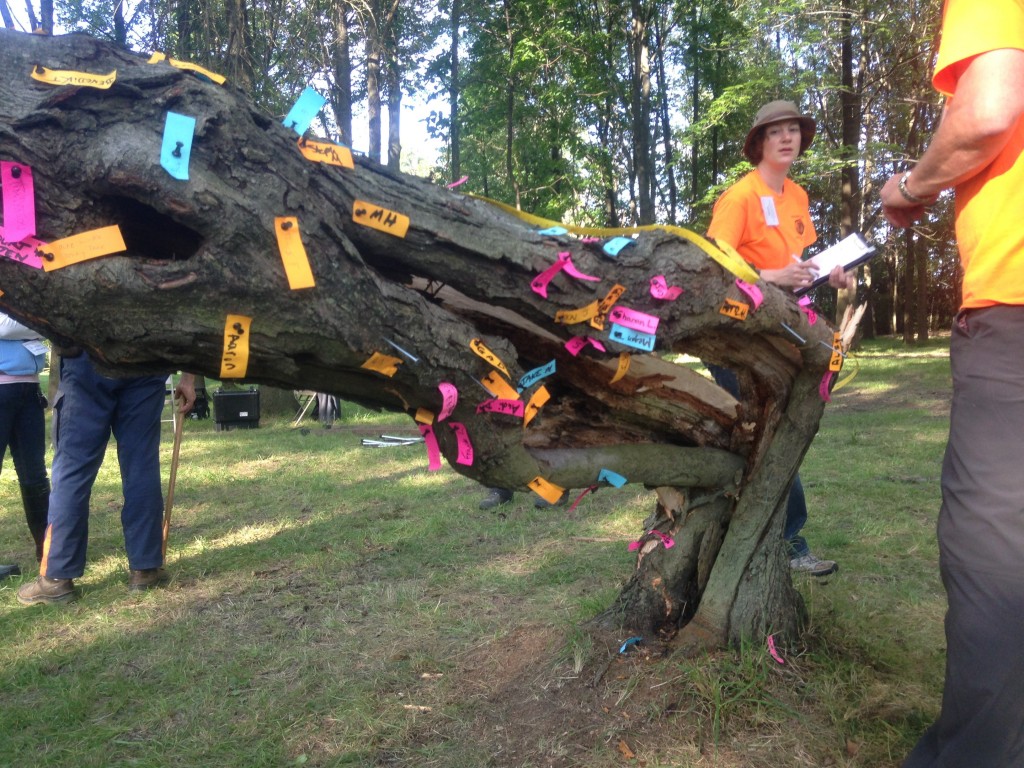
40 researchers and technicians marked the spots where they reckoned the tree would fail. Most of the bets were clustered around the compression side, at the hollowest part of the trunk.
The Wager Tree at 2013’s Biomechanics Week had huge ribs of woundwood around an ugly hollow. The Acer rubrum, red maple tree faced the road, indicating mechanical damage years before. It stood up to 4.5 kilonewtons (1011 pounds) of pull before visibly failing on the other (tension) side: first above the cavity, then at a mower-damaged tension root. The trunk twisted apart—delaminated– on the way down. After the brush was cut off, it zipped itself back together, as it was pushed back up to vertical. The structural tissue around the cavity was restored.
Response growth, such as self-grafting, or “relamination”, will be studied at the next Biomechanics Week. As Dr. Gilman noted, “We know next to nothing about tree biomechanics”. Formal research is non-existent on crown reduction of mature trees. Their complex nature involves too many variables. We must confine our speculations within our limitations, and follow the tree’s direction.
When asked “How can this tree be pruned so it is safer?” inexperienced arborists often say what they will NOT do: top the tree, or make ‘heading cuts’. But few are aware of what exactly TO do. Collar cuts can be fatal. Risk-averse assessors may measure the hollows at big pruning wounds, apply a formula riddled with assumptions, limitations, and generalised rules, and condemn the trees. Published guidance on pruning older trees is scarce, so one must look abroad. The German ZTV standard costs 20 euros ($28USD) and contains comprehensive guidance on pruning, support, business contracting, and more.
Arborists around the world are recording and presenting their regeneration work, to support our industry’s evolution. They seek to harmonise with each other, and the mature trees they are called on to manage. If your work involves crown regeneration, please contribute when your country’s pruning standard is next revised. References
- BS 3998: 2010 Tree Work—Recommendations British Standards Institute
- ZTV Baumpflege…German Guidelines for Tree Care www.fll.de/shop
- Geholzschnitt: nach den Gesetzen der Natur, Pfisterer, Jochen. Ulmer, Eugen, 1999
- Best Management Practices on Tree Risk Assessment, ISA (page 43)
- Arboriculture: The Integrated Management of Trees, Shrubs and Vines Harris et al
- How Hollow may a Tree be? Wessolly, Neue Landschaft 11/96 p. 847-850
- Risk Assessment Criteria for Branch failure, Goodfellow, John 2009, BioCompliance Consulting
- Foundations of Tree Risk Analysis Bond, Jerry, Arborist News, ISA June 2006
- ANSI A300 Tree Care Standard, Part 8 Root Management Tree Care Industry Association
- Compartmentalization of Decay in Trees Shigo, Alex L., Agric. Inf. Bull. 405, USDA 1977


